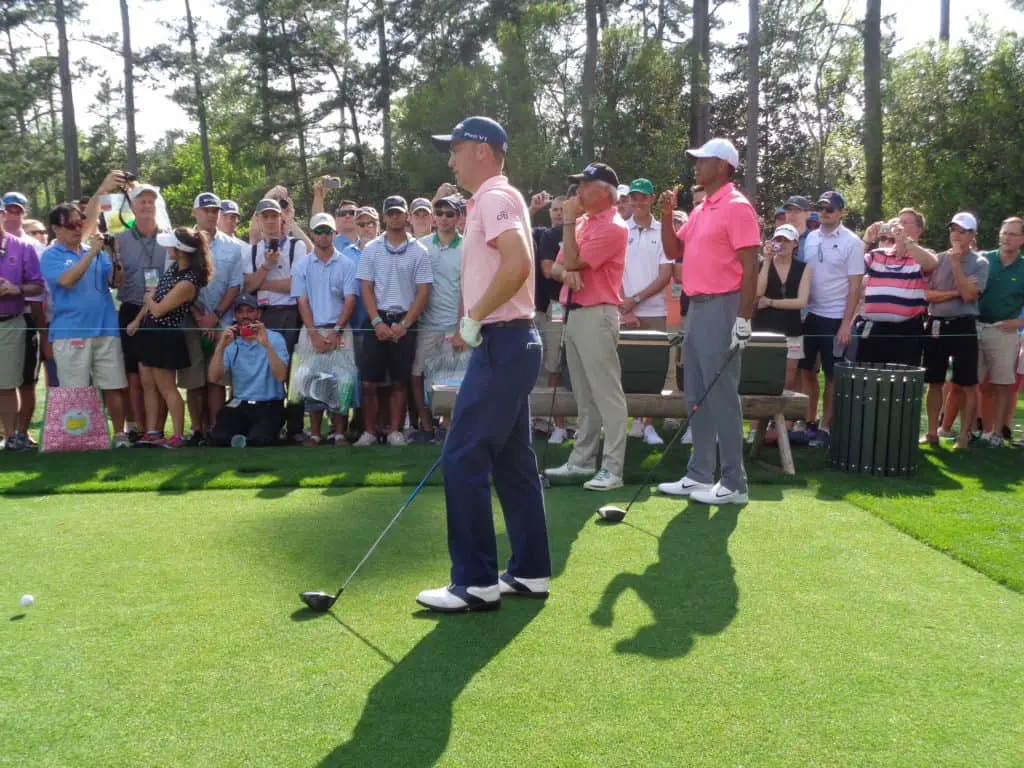- Understand the ball flight laws relative to the hook in golf
- Diagnose your swing issue causing the hook in golf
- Work on a drill to align your club face and swing path
- Take it to the course and focus on a target
- Read your ball flight during the round
There aren’t many things worse in golf than fearing the hook shot.
The golfer can stand on the tee and fear the golf ball overdrawing or hooking well to the left.
The absolutely worse version of this shot is the snap hook. The low fly shot that hooks severely and doesn’t carry very far.
Some good news though, there are 5 simple steps you can take to fix this issue with the golf swing. Other good news is that the hook shot is often the sign of a quality golfer and the simple solutions below can get you right back on track.
As someone that once struggled from the snap hook, I feel your pain, but also have solved this case for myself.
How To Fix A Hook in Golf (5 Simples Steps)
My Journey: Let’s focus on #2 above. I struggled with the hook or the over draw for many season. I finally figured out several things causing the hook. The main swing fault was my body would get ahead of my arm swing and my hands would try to catch up. The path was too far in to out and then I closed the face hard. Once I was able to synch up my body and my arms to be more aligned and timed up together, I was able to eliminate this shot!

Step #1: Understand the ball flight laws relative to the hook in golf
The first step in this journey is to understand the ball flight laws and what is causing the hook. The hook occurs when the clubface is closed relative to the swing path. The ironic part is that this shot can occur with an open club face at impact if the path is too far right.
Here are some of the basics of the ball flight laws:
- The golf ball will start relative to the direction of the club face at impact.
- The golf ball will curve away from the swing path.
- So if your clubface is left of the swing path at impact, the ball will curve left. If your clubface is right of the swing path at impact, the ball will curve right.
Obviously, with the hook shot in golf, the path is too far right of the clubface and there is too large of a gap between the club face and the swing path.
Hook vs Slice: What is the difference?
Here are some examples of a hook shot in golf and the ball flight laws:
- Shot: Ball starts right and hooks left. This is a clubface that is open at impact with a path too far to the right. Potential numbers could be a 2 degree open club face with a 12 degree path inside to out or to the right. We have a gap of 10 degrees between clu
- Shot: Ball starts left and hooks left. This is a clubface that is closed at impact with a swing path that is to the right of the club face. Potential numbers could a a 3 degree closed club face with a 7 degree swing path to the right. We have a gap of 10 degrees between clubface and swing path.
Some key items to point out:
- If the curve is extreme, there is a large gap between your clubface and your swing path.
- If the curve is soft, there is a small gap between your clubface and your swing path.
- Arguably the most difficult shot to hit in golf is the straight shot. This requires a perfectly square clubface with a 0 degree path.
While we don’t promote the perfectly straight shot in golf, too large of a gap between club face and swing path is difficult to control and manage. The opposite of the hook is the slice and has the opposite numbers of the hook and is a shot that many high handicap level golfers struggle with.
Step #2: Diagnose your swing issue causing the hook in golf
There are several issues that could be causing your major gap in numbers between the club face and the swing path. These include the following:
- Issue 1: Stalling in the downswing. The hips stall, causing the hands to flip through the zone. On certain days you might time it up fine, but may struggle the next day.
- Issue 2: Extreme sliding of the hips. The sliding of the hips can cause the path to move more and more to the right. Once the hips start to turn, the club heads more left.
- Issue 3: Improper release. If you watch the better golfers in today’s game, the release is more of an underhand toss, similar to smacking something or tossing a ball understand. This keeps the club from flipping through the zone.
- Issue 4: Getting stuck. This is where the club head gets too far behind you at impact and as a result have to flip through the zone to try to time everything up properly. This is usually a sequencing issue where the lower body out races the upper body. While the lower body is always going to start first, a feel or the arms moving sooner can help alleviate this issue.
- Issue 5: Getting ahead of the shot. Sometimes the upper body and head can move past the ball. The better golfer tries to save the shot by being over active with the hands, causing the swing to have perfect timing on that day to play a quality round.
I would recommend taking a video of your swing from both the side view and the down the line view. Use some lines and try to identify which of the 5 items above is causing your hook. Do you think it is more of a clubface issue or more of a swing path issue?
What is the best swing path for a driver?

Step #3: Work on a drill to align your club face and swing path
Sometimes focusing on the results can help get everything back on line. There are some simple solutions you can trying relative to the issues above:
- Stalling: Focus on keeping the body moving through the shot. One thought is to make a complete turn back and through.
- Sliding of the hips: Focus on getting your front help off the ground and then in the downswing squatting and turning vs sliding forward.
- Improper release: Attempt to take some half to 3 quarter shots and use a slapping motion or a fade release feel.
- Getting Stuck: Work on keeping the club more in front of you or almost feeling as if you are going to swing over the top slightly to get it back on the right path.
- Getting ahead of the shot: See the back of the ball and stay behind the ball through impact.
Another option is to put this drill into your normal routine.
Stock Shot Drill
- At the driving range, set up an alignment stick about 6-8 yards in front of you, straight down your target line.
- If you have a second alignment stick, set the stick 3-4 feet right of the first stick (for a draw) or left of the first stick (for a fade).
- Complete your initial assessment see how many times out of 10 you can start the ball to the right or left of your target. Pick one side and measure your game at this point.
- The goal is to eventually get 7 out of 10 shots to start to the correct side and draw back towards the target.
We believe the swing path is only 2nd in importance to the clubface in the golf swing.
Check out this post: What is the most important part of the golf swing?
Step #4: Take it to the course and focus on a target
One of the most difficult transitions is taking a new feel or swing thought to the course. Oftentimes we can get golf ball bound and focus too much on a variety of positions. Instead, work on the feel during your pracitce swing and then turn your attention to a target. Swing with confidence towards the target you have select and try to focus on one simple key.
For example: moving through the shot or having a slap or fade release. Whatever you worked on at the driving range, but don’t lose sight of the target and help the game become more reaction based. Oftentimes when we try to control everything we can stall, get flippy or many of the other issues with hooking a shot.
Open club face in golf: pros and cons

Step #5: Read your ball flight during the round
The best golfers can take feedback after every shot through reading their ball flight. Keep in mind the ball flight laws the general basics about where a ball will start and what direction it will curve. The more you can become an expert at reading the ball flight, the better adjustments you can make. Understand what the hook shot feels like and what a quality swing feels like. Read that ball flight and have your go to feel to fight the hook mid round. When in doubt, make sure you stick with a fade release and keep your body moving.
Lack of Rotation in the golf swing (3 Causes)
Final Thoughts
I would highly recommend using a golf launch monitor to help measure your clubface and your swing path. Once again, as these two numbers get too large of a gap, the golfer is going to fight the hook shot in golf. I purchased a Skytrak Launch Monitor several years ago and the feedback is rather impressive. After every shot, you can receive the following:
- Carry and Total Distance
- Spin Axis
- Spin Rate
- Swing Path
- Launch Angle
- Ball Speed
- Club Speed
In addition, the shot tracer is rather helpful in getting feedback. If you understand the ball flight laws, the shot tracer gives you the immediate feedback about where your clubface was at impact as well as your swing path based on the curve of the ball.
Check Current Price of Skytrak Launch Monitor, Here!
My Secret To Golf Improvement
Let’s face it, in order to get really good at golf, we must practice frequently. About four years ago, I made the leap and invested in a golf simulator build for my garage. I went with a SkyTrak Launch Monitor and the TGC software and can now play over 100,000 courses including Augusta, Pebble Beach, Bethpage Black, Whistling Straits. St. Andrews and many other of the top 100 courses in the world.
This golf simulator setup, which is more affordable that you might imagine, has been a game changer. I can now play golf everyday of the year regardless of rain, snow, cold weather or time of day. I can practice or play rounds of golf. I can stand in the 11th fairway at Augusta and with the auto-rewind feature I am able to practice my approach shots from various differences.
It is worth checking out through Rain or Shine Golf as they offer some incredible packages along with financing offers that are difficult to beat.
Some direct links to Rain or Shine Golf for pricing and financing:
Take Action – What You Can Do Today to Get Better
What does this mean for you? I believe in the following recipe to get better:
1 – Improve your motion in the golf swing by identifying a golf instructor. Here are some options:
Here is a list of golf instructors that we have reviewed:
2 – Train to swing faster and improve your swing speed. Here are some options:
Looking to gain more Speed and Distance in your swing. Two Options:
3 – Understand course strategy and work to break through your next barrier. Here is a series on breaking through:
We have provided guides on how to break 100, 90, 80 and 70. Check out more below, if interested.
4 – Practice Frequently
Did you know that I build a golf simulator in my garage and have played over 500 rounds of golf on my SkyTrak system? It has been a game changer and one worth checking out. Here are some of my other posts on golf simulators frequently asked questions:
- Is a Golf Simulator Worth It?
- How to Build a Golf Simulator?
- What is the Best Golf Simulator?
- Golf Simulator Accessories?
- How to Build a Golf Simulator for under $7000
- Top 11 Reasons to Buy a SkyTrak
- How to Build a Golf Simulator for Under $1000
- Why Build A Golf Simulator?
- What Space is Needed?
- Can A Golf Simulator Improve My Game?
- How Much Does A Golf Simulator Cost?
- Don’t Forget to Check out our 15 best golf swings of all time.
